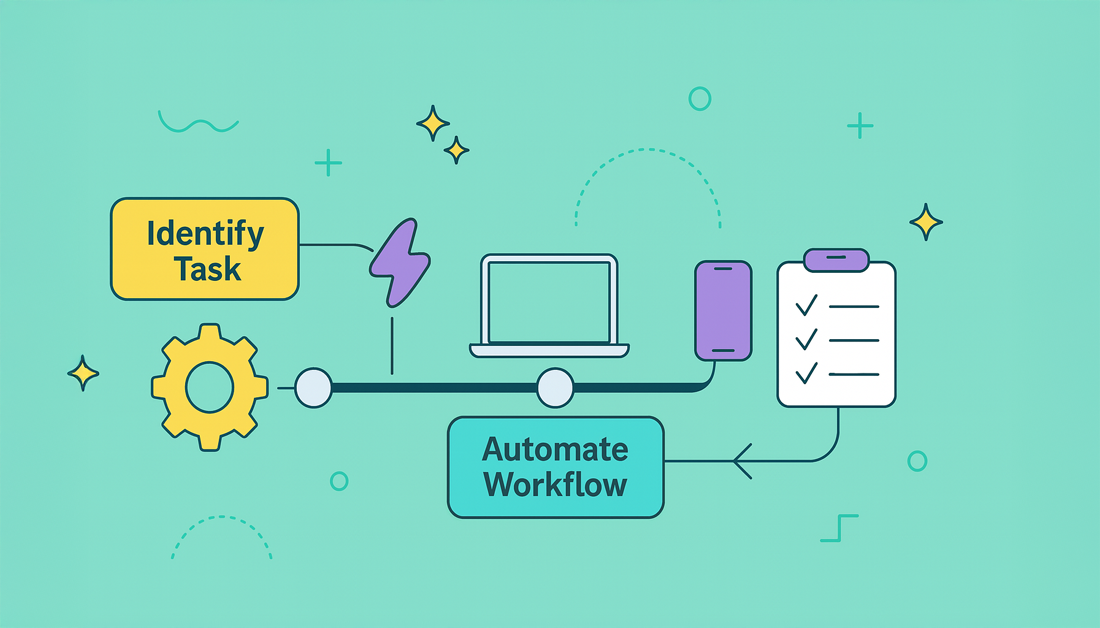Tired of feeling like a hamster on a wheel, buried under a mountain of repetitive tasks? You’re in the right place. Workflow automation isn’t just about saving a few clicks; it’s about reclaiming your time, eliminating soul-crushing manual work, and freeing up your team to focus on what actually matters. But knowing you need automation and knowing what to automate are two very different things. This is where most teams get stuck, staring at a blank canvas of possibilities.
This guide cuts through the noise. We’re not just talking theory; we’re diving deep into practical, real-world workflow automation examples you can steal and implement today. From streamlining marketing campaigns with monday.com to supercharging IT support with Jira and Resolution, we’ll break down the strategic “why” and tactical “how” for each scenario. To truly grasp the power of these automations, it’s essential to understand the key workflow automation benefits that drive efficiency and growth across every department.
Get ready to see how tools like Zapier, ClickUp, and Kissflow are being used by savvy teams to connect apps, manage projects, and crush deadlines. Each example includes a strategic breakdown, screenshots, and actionable takeaways so you can stop dreaming about efficiency and start building it. Let’s get to it.
1. resolution Reichert Network Solutions GmbH
Kicking off our list is a powerhouse integration that solves one of the most persistent headaches in modern business: the dreaded information silo. Developed by resolution Reichert Network Solutions GmbH, the monday.com for Jira app is a stellar example of workflow automation that doesn’t just connect tools, it unifies entire teams. It creates a seamless, two-way bridge between monday.com’s vibrant project planning environment and Jira’s robust development tracking, ensuring your marketing, operations, and engineering departments are always speaking the same language.
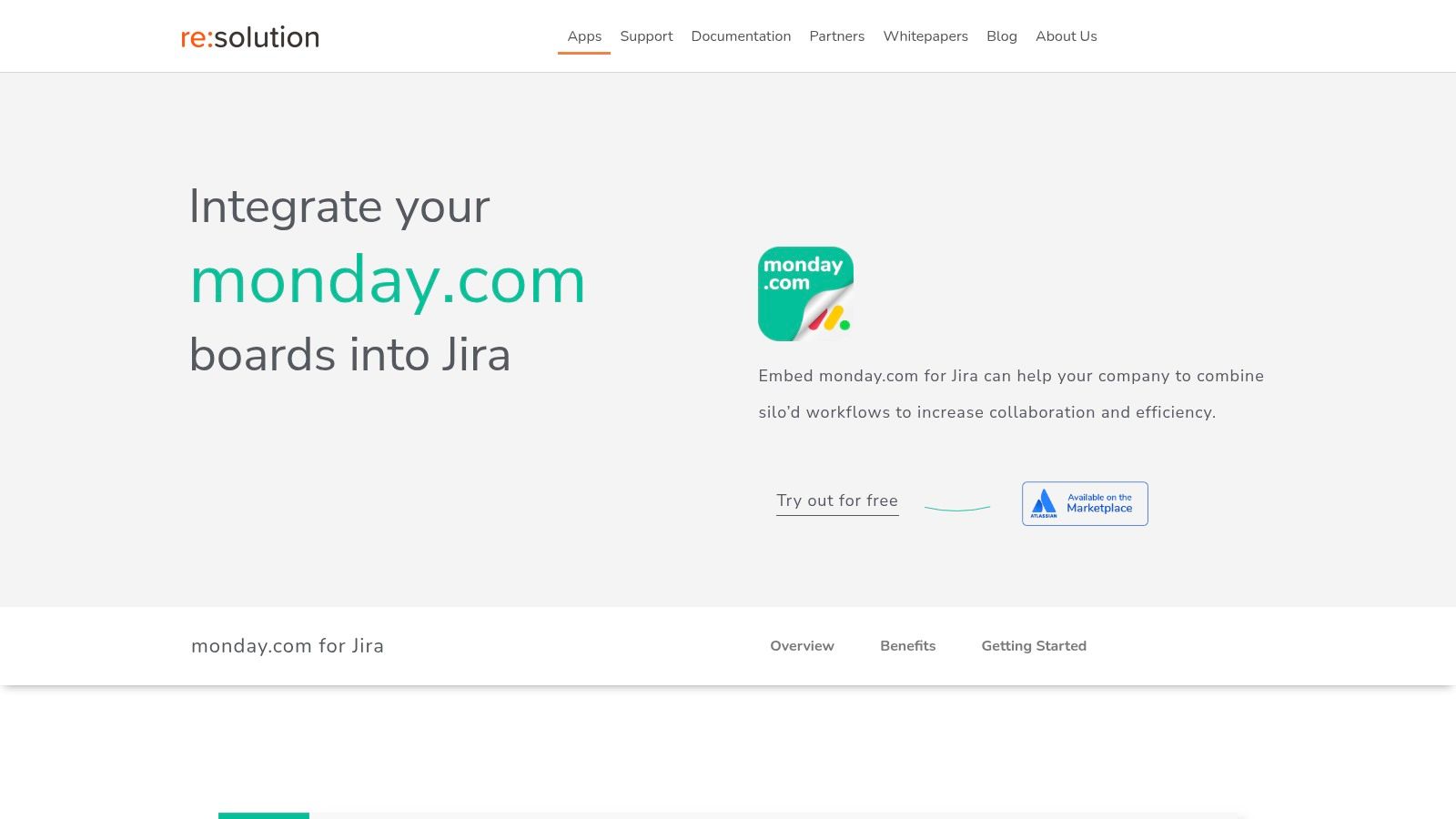
This app is more than a simple connector; it’s a command center. By allowing you to embed interactive monday.com boards directly within Jira issues and, conversely, create and edit Jira tickets from your monday.com workspace, it eliminates the need to constantly switch tabs. This real-time synchronization is a game-changer for cross-functional teams, ensuring updates, comments, and status changes are reflected instantly on both platforms.
Strategic Analysis: Unifying Disparate Workflows
The true genius of this tool lies in its ability to consolidate visibility. Imagine your campaign leads planning a product launch on a monday.com board, with timelines, creative assets, and calendars all in one place. With this integration, they can link their tasks directly to the development team’s epic in Jira. When an engineer updates a ticket, the marketing team sees it in real-time, allowing for agile adjustments without a single status meeting.
Key Insight: The app’s standout feature is offering read-only access to stakeholders without requiring extra monday.com licenses. This dramatically cuts software costs and encourages transparent collaboration with executives, clients, or other departments who just need to stay informed.
Actionable Takeaways & Unique Features
This platform is a masterclass in providing practical workflow automation examples that drive efficiency and cut costs. Here’s how you can leverage its capabilities:
- Boost Transparency: Embed monday.com charts and timelines into a Jira dashboard to give leadership a high-level view of project progress without needing access to monday.com.
- Streamline Support: Allow support agents working in Jira to create a task for the operations team in monday.com directly from a customer ticket, ensuring a smooth handoff.
- Secure Collaboration: Use the customizable user permissions to control who can view or edit embedded boards, safeguarding sensitive project data while keeping relevant teams in the loop.
The app is an essential tool for any organization looking to scale its agile processes and improve its digital transformation roadmap with a practical, high-impact integration. This tool is a prime example of how targeted workflow automation can dissolve departmental barriers and accelerate decision-making across the board.
| Feature Highlights | Key Benefits |
|---|---|
| Real-Time Two-Way Sync | Eliminates data discrepancies and keeps teams aligned. |
| Cross-Platform Editing | Create Jira tickets from monday.com & vice versa. |
| License-Free Read-Only Access | Reduces software overhead and boosts stakeholder visibility. |
| Customizable Permissions | Enhances data security and information relevance. |
Pros:
- Flawless real-time synchronization between monday.com and Jira.
- Significantly reduces software costs with license-free read-only access for stakeholders.
- Deeply embeds boards and items, creating a truly unified workspace.
- Highly customizable permissions and notifications for secure, relevant updates.
Cons:
- Requires active subscriptions to both monday.com and Jira for full functionality.
- The initial setup of advanced permissions might present a slight learning curve.
Ready to bridge the gap between your teams? Explore monday.com for Jira on resolution.de
2. ClickUp
ClickUp positions itself as the “one app to replace them all,” and for workflow automation, it makes a compelling case. It’s a productivity platform that feels less like a rigid project manager and more like a set of powerful, interconnected LEGO bricks you can snap together to build your team’s perfect operational mothership. Instead of just tracking tasks, ClickUp automates the busywork between them, which is where most teams bleed time and sanity.
Its real magic lies in its “Automations” feature. Think of it as your personal army of digital butlers. You can set up triggers, like a task status changing to “In Review,” and define a corresponding action, like automatically assigning it to the team lead and posting a notification in a specific Slack channel. This turns clunky, manual handoffs into a seamless, instantaneous flow.
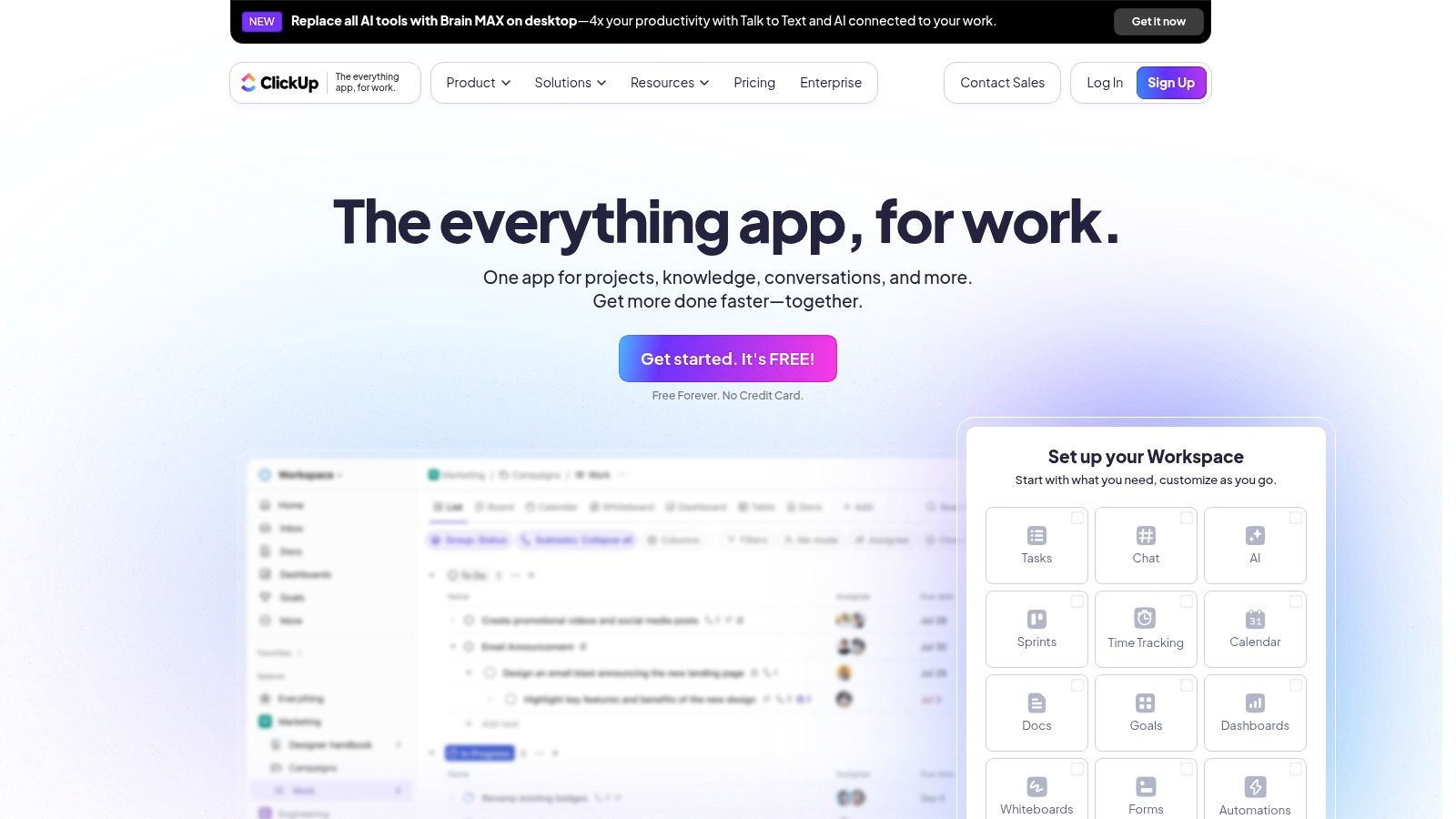
Why It’s a Top-Tier Automation Tool
What makes ClickUp a standout in a crowded field is the sheer depth of its customization married to a surprisingly user-friendly interface. While competitors might offer canned automations, ClickUp lets you build complex, multi-step recipes without writing a single line of code. It’s one of the best workflow automation examples because it democratizes powerful process building for non-technical teams.
Strategic Insight: ClickUp’s core advantage is its combination of granular control and template-driven accessibility. You can start with a pre-built recipe like “When due date arrives, change priority to Urgent,” and then layer on custom conditions, such as “…but only if the task is in the ‘Marketing’ list and has the ‘Campaign’ tag.”
Key Features and Practical Tips
- Automation Recipes: ClickUp offers over 100 pre-built automation templates. Pro Tip: Don’t just use them as-is. Treat them as a starting point. Find one that’s close to your needs and then duplicate and customize it to perfection.
- Custom Fields Integration: Automations can read and write to custom fields. Use this to automatically calculate project costs, update progress percentages, or even assign a risk score based on task tags.
- Robust Integrations: It connects with everything from Slack and Google Drive to GitHub and Twilio. This allows you to build automations that span your entire tech stack, like creating a new ClickUp task directly from an email in your inbox.
| Feature | What It Is | Pro Tip for Automation |
|---|---|---|
| Dependencies | Links tasks that must be done in a specific order. | Set an automation to unblock a dependent task and notify the next person in line the moment the prerequisite task is completed. |
| Templates | Reusable structures for tasks, lists, or folders. | Automate template application. For example, when a task is moved to the “New Client” list, automatically apply the “Client Onboarding” checklist template. |
| Views | Different ways to see your data (List, Board, Calendar, Gantt). | While not a direct automation, use views to monitor your automated workflows. Create a “Stalled Tasks” view that filters for items that haven’t moved status in 3 days. |
ClickUp offers a generous Free Forever plan with limited automations. Paid plans (Unlimited, Business, Enterprise) unlock more advanced features and a higher volume of automation runs, starting at a competitive price point. The platform can feel overwhelming at first due to its feature density, but investing a little time in its “Automations” hub pays massive dividends in reclaimed productivity.
Find it here: https://clickup.com/
3. Zapier
Zapier is less of a single application and more of the universal translator for your entire software suite. It acts as a digital switchboard, connecting over 5,000 different apps and allowing them to talk to each other without needing a developer on standby. Its core mission is to automate the manual, repetitive tasks that happen between your favorite tools, turning a series of disconnected actions into a single, seamless workflow.
The platform’s power comes from its “Zaps,” which are simple “if this, then that” automations. You define a trigger in one app, like receiving a new Typeform submission, and then an action in another, like creating a new lead in Salesforce and adding a row to a Google Sheet. This transforms tedious, error-prone data entry into an instantaneous and reliable process, making it one of the most powerful workflow automation examples for connecting a diverse tech stack.
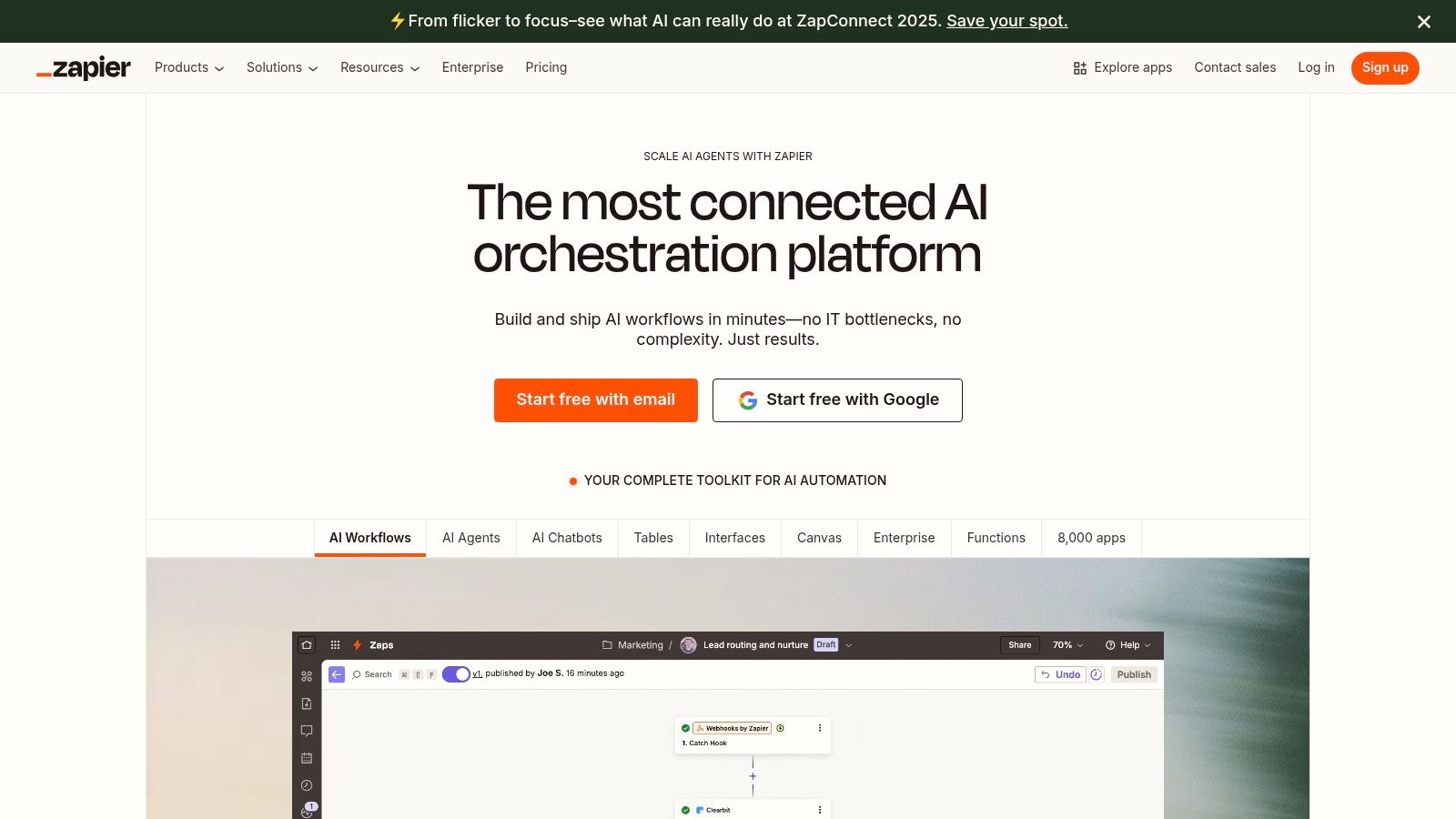
Why It’s a Top-Tier Automation Tool
What sets Zapier apart is its staggering number of integrations and its unparalleled accessibility for non-technical users. While other tools automate workflows within their own ecosystem, Zapier is fundamentally ecosystem-agnostic. It’s the ultimate bridge-builder. You don’t need to know what an API is to use it; you just need to know what you want to accomplish, and Zapier’s friendly drag-and-drop interface guides you the rest of the way.
Strategic Insight: Zapier’s true value lies in its ability to democratize cross-app automation. It empowers every team member, from marketing to HR, to build their own solutions. You can start with a simple two-step Zap and then scale up to complex, multi-step workflows with conditional logic (Paths) that execute different actions based on the incoming data.
Key Features and Practical Tips
- Massive App Directory: With over 5,000 integrations, the odds are high that the apps you use are already on Zapier. Pro Tip: Before building a complex Zap, explore the pre-made templates for your chosen apps. They often cover common use cases and can be customized in minutes.
- Multi-Step Zaps: Go beyond a simple trigger and action. A single trigger can set off a chain reaction of multiple actions across different applications, building sophisticated operational sequences.
- Paths & Filters: Use Paths to create conditional logic (e.g., if a customer email contains “support,” send it to Zendesk; if it contains “sales,” send it to HubSpot). Use Filters to ensure a Zap only runs when specific conditions are met. If you want to dive deeper into this, you can learn more about how Zapier can automate data entry on resolution.de.
| Feature | What It Is | Pro Tip for Automation |
|---|---|---|
| Formatter by Zapier | A built-in tool to transform data within a Zap. | Use it to automatically format dates, capitalize text, or extract email addresses from a block of text before passing the data to the next step in your workflow. |
| Schedule by Zapier | A trigger that allows you to run a Zap on a recurring schedule. | Set up a Zap to run every Friday afternoon to compile a weekly summary of new leads from your CRM and post it in a Slack channel. |
| Webhooks | A more advanced trigger for apps not officially on Zapier. | If you use a niche tool with webhook capabilities, you can still connect it to the Zapier ecosystem to trigger workflows. |
Zapier offers a Free plan with a limited number of single-step Zaps and tasks. Paid plans (Starter, Professional, Team, Company) unlock multi-step Zaps, premium apps, and higher task limits, with pricing scaling based on usage. While complex Zaps can have a learning curve, its user-friendly design makes it the go-to for teams looking to automate processes without writing code.
Find it here: https://zapier.com/
4. Kissflow
Kissflow is designed for the business user who sees a broken process and thinks, “There has to be a better way,” but doesn’t have the time or coding skills to build a solution from scratch. It’s a low-code/no-code work platform that excels at turning messy, email-and-spreadsheet-based operations into streamlined, automated applications. Instead of forcing your processes into a rigid project management tool, Kissflow gives you a canvas to build the exact workflow you need, from employee onboarding to purchase order approvals.
The platform’s core strength is its visual, drag-and-drop workflow builder. It allows non-technical managers to map out process steps, define business rules, set deadlines, and assign tasks as if they were drawing a flowchart. This transforms the often-abstract concept of “process improvement” into a tangible, interactive, and fast-to-deploy digital solution.
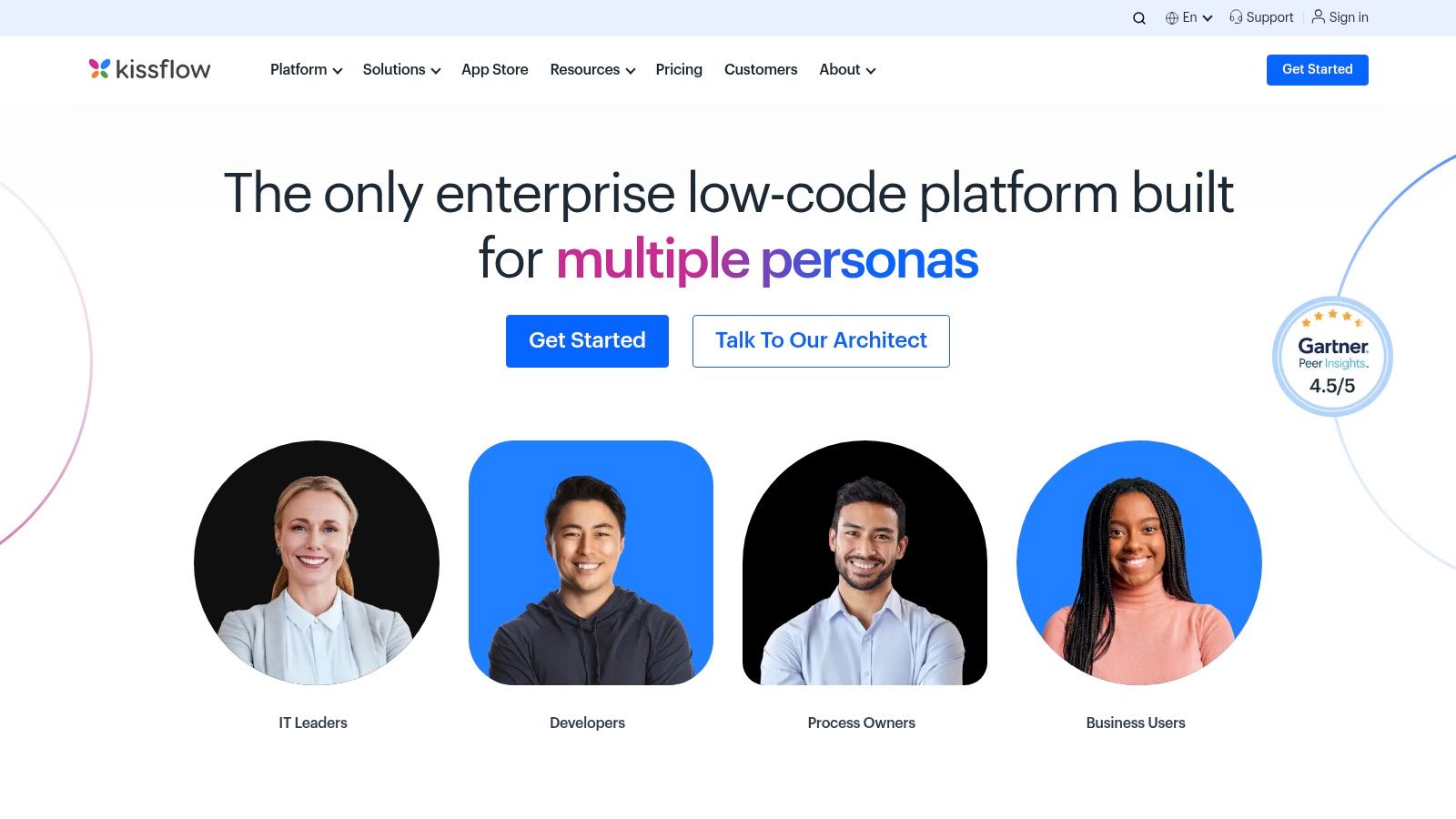
Why It’s a Top-Tier Automation Tool
Kissflow’s brilliance lies in its accessibility and speed-to-value. While other platforms offer powerful automation, Kissflow is purpose-built to get a functional workflow live in hours, not weeks. It stands out as one of the best workflow automation examples because it specifically targets the operational “long tail” of processes that are too specific for off-the-shelf software but too small to justify a major IT project. It’s automation for the rest of us.
Strategic Insight: Kissflow’s competitive edge is its laser focus on structured, form-based processes. It shines brightest when a workflow begins with a request (like a leave request or a budget proposal) that needs to travel through a specific series of approval stages with clear accountability at each step.
Key Features and Practical Tips
- Drag-and-Drop Builder: The visual interface is the heart of Kissflow. Pro Tip: Before you drag a single element, sketch your process on a whiteboard. Identify every step, decision point, and person involved. This blueprint will make building the digital version incredibly fast.
- Pre-Built Templates: Kissflow offers a library of templates for HR, finance, and procurement. Use these to understand best practices and then customize them to fit your company’s unique policies.
- Real-Time Analytics: Dashboards show you where bottlenecks are forming in real-time. This isn’t just for reporting; it’s a tool for continuous improvement. If you see tasks piling up at one stage, you know exactly where to investigate. This is a critical aspect when you seek to automate administrative tasks.
| Feature | What It Is | Pro Tip for Automation |
|---|---|---|
| Process Forms | Customizable forms that initiate a workflow. | Use conditional logic within your forms. For example, if an expense claim is over $500, automatically reveal a field requiring a manager’s pre-approval code. |
| Role-Based Access | Defines what users can see and do in a workflow. | Create roles like “Initiator,” “Approver,” and “Finance Reviewer.” Automations can then dynamically assign tasks to whoever currently holds that role, making staff changes seamless. |
| Integrations | Connects to tools like Google Workspace and Microsoft Office. | Automate workflow initiation from your inbox. Set up a rule where an email sent to “invoices@company.com” automatically creates a new item in the “Invoice Processing” workflow. |
Kissflow’s pricing is tiered, starting with plans for small teams and scaling up to enterprise-level solutions. While it can be more expensive than some simpler tools, its value is in the rapid deployment and ease of use for non-developers. The user-friendly interface significantly lowers the barrier to creating powerful, custom business applications.
Find it here: https://kissflow.com/
5. Nintex
If your organization’s processes are less about creative tasks and more about iron-clad, high-stakes business operations, Nintex is the enterprise-grade heavyweight champion. It moves beyond simple task management to orchestrate complex, end-to-end business processes, especially those bogged down by documents, approvals, and compliance requirements. Think of it not just as a workflow automator, but as a digital transformation platform that rebuilds your core operations from the ground up, minus the code.
Nintex excels where processes are intricate and touch multiple systems, like HR onboarding, contract management, or financial approvals. Its power comes from turning labyrinthine, manual procedures into streamlined, automated, and auditable digital journeys. It’s the tool you bring in when “good enough” automation simply isn’t good enough for your mission-critical functions.
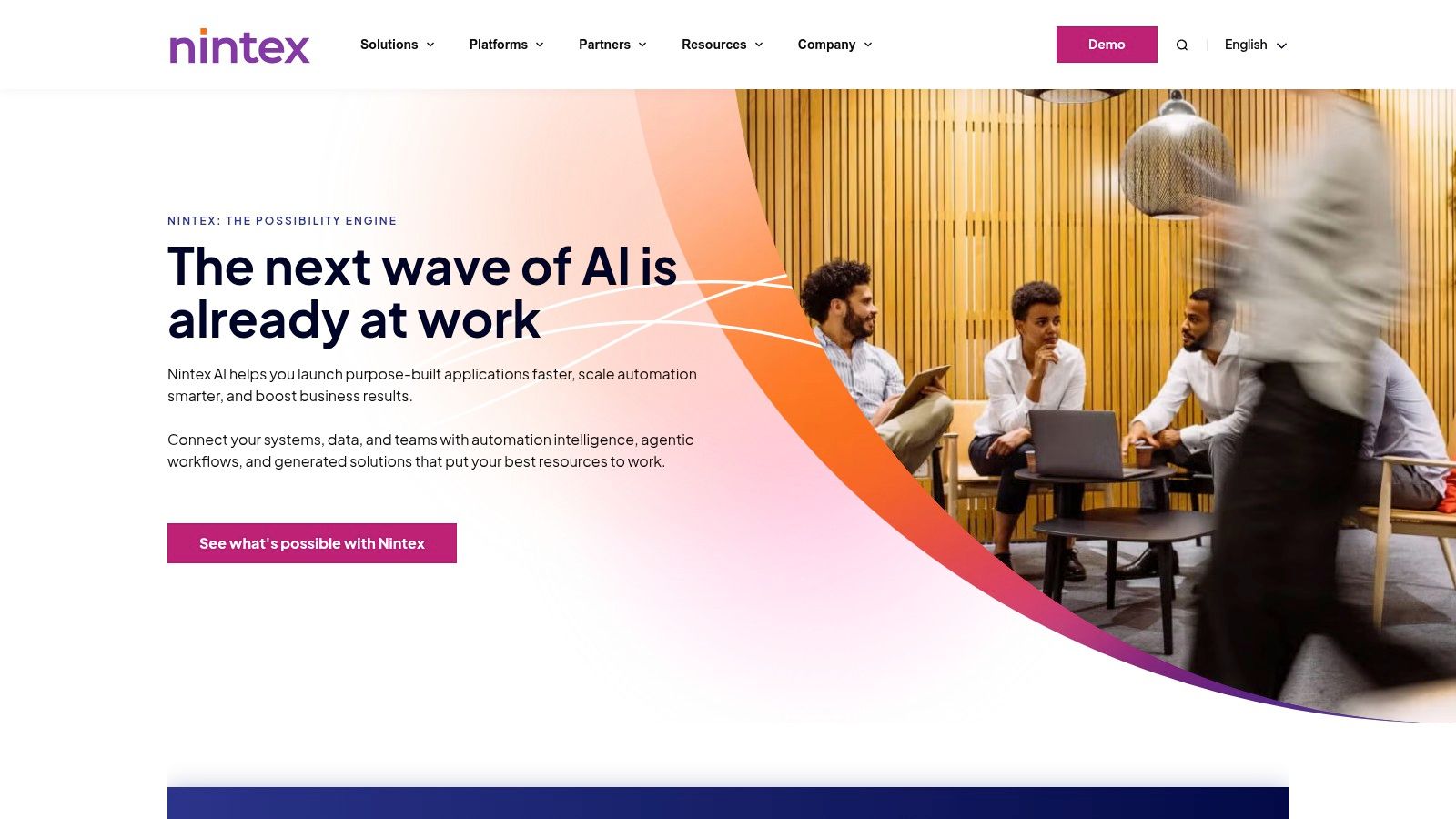
Why It’s a Top-Tier Automation Tool
Nintex stands out with its uncompromising focus on deep, enterprise-level process automation, combined with a surprisingly intuitive no-code, drag-and-drop interface. Where other tools might handle a piece of the puzzle, Nintex aims to automate the entire board game. It’s one of the most powerful workflow automation examples because it provides the tools to digitize highly regulated and document-heavy processes that are often left behind by lighter-weight solutions. For a deeper dive into what’s possible, you can learn more about these kinds of business process automation examples.
Strategic Insight: Nintex’s core strength is its ability to manage the entire lifecycle of a process, from form submission and workflow logic to document generation and final e-signature. This integrated approach eliminates the need to stitch together multiple niche tools, reducing points of failure and creating a single source of truth for your most critical operations.
Key Features and Practical Tips
- Drag-and-Drop Workflow Designer: Build sophisticated workflows visually. Pro Tip: Map out your process on a whiteboard first. The visual designer makes it easy to translate that real-world map into a digital, automated reality.
- Advanced Document Automation: Automatically generate contracts, proposals, or reports by populating templates with data from your systems (like Salesforce), then route them for approval and e-signature.
- Deep Microsoft Integration: Nintex has deep roots in the Microsoft ecosystem, offering powerful integrations with SharePoint, Office 365, and Dynamics 365. This makes it a natural fit for organizations already invested in Microsoft’s tech stack.
| Feature | What It Is | Pro Tip for Automation |
|---|---|---|
| Nintex Forms | A tool for creating dynamic, intelligent online forms. | Use rules within your forms to show or hide fields based on user input, pre-populating data to reduce manual entry and errors. |
| Nintex K2 Cloud | The engine for designing and running complex, mission-critical process apps. | Use it to automate cross-departmental processes, like new employee onboarding that involves IT, HR, and Finance in a single, seamless workflow. |
| Real-Time Analytics | Dashboards to monitor the health and performance of your workflows. | Set up alerts for process bottlenecks. If a contract approval has been sitting with one person for over 48 hours, automatically send a reminder. |
Nintex’s pricing is tailored for enterprise use and typically requires a consultation to get a custom quote. While its advanced features come with a learning curve, its user-friendly designer makes it accessible for business analysts and operations managers, not just IT developers.
Find it here: https://www.nintex.com/
6. Workato
If other automation tools are like powerful sedans, Workato is the enterprise-grade freight train. It’s an AI-powered, integration-platform-as-a-service (iPaaS) designed not just to connect a few apps, but to orchestrate complex, business-critical workflows across an entire organization. Workato doesn’t just pass data; it transforms, enriches, and acts upon it in real-time, making it the central nervous system for operations at scale.
This platform is built for the heavy-duty lifting that makes IT and operations leaders nervous: synchronizing financial data between NetSuite and Salesforce, automating employee onboarding across HRIS, IT, and finance systems, or managing intricate supply chain logistics. It’s where you go when “if this, then that” is no longer enough and you need “if this, and this, but not that, then query this other system, transform the data, and update three separate records.”
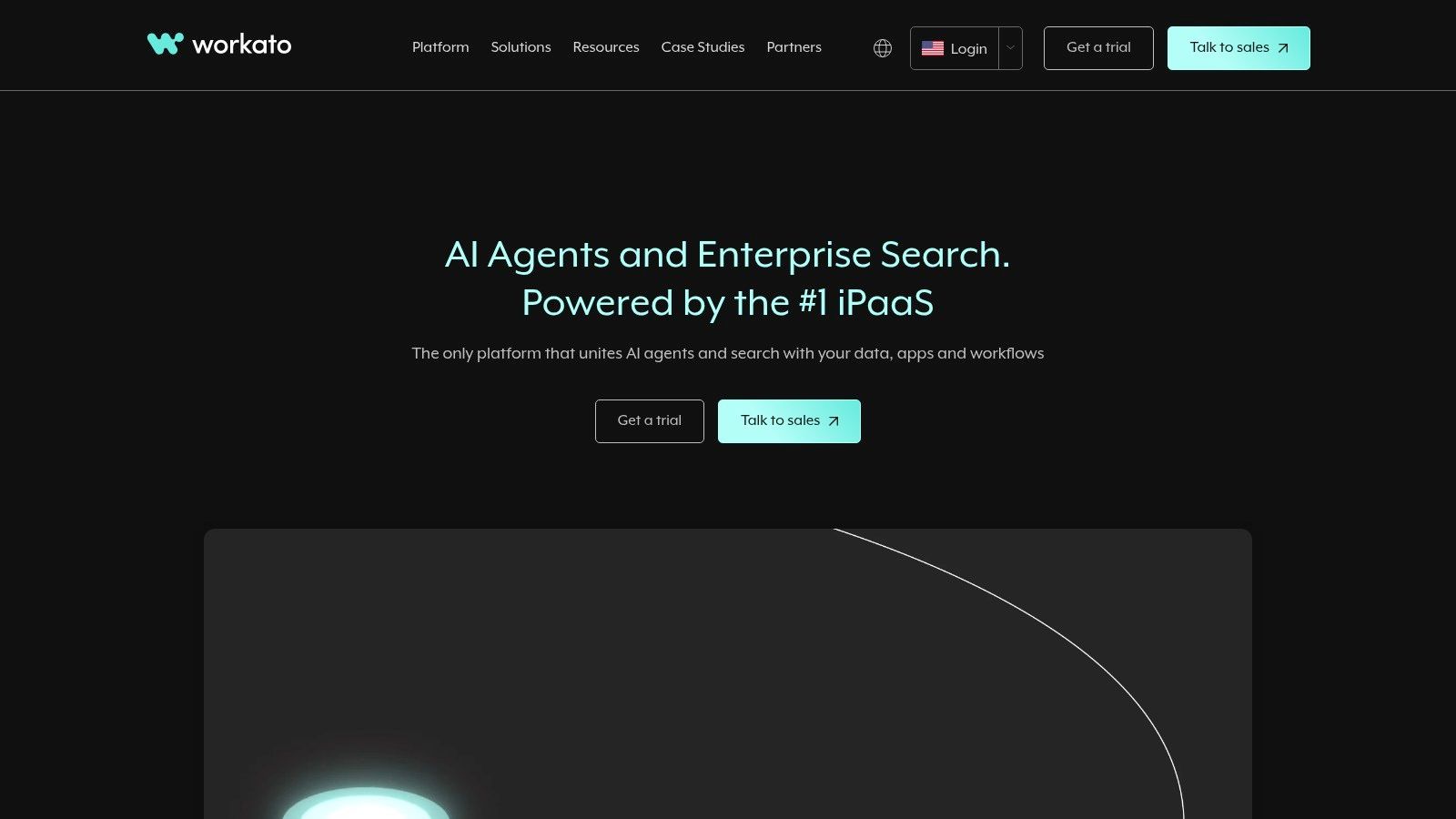
Why It’s a Top-Tier Automation Tool
Workato’s power lies in its ability to handle immense complexity while maintaining a low-code/no-code interface. It brings enterprise-level integration capabilities, once the exclusive domain of developers, to business technologists and operations managers. This makes it one of the most powerful workflow automation examples for large organizations seeking to break down data silos between departments like finance, sales, and HR without a massive custom development project.
Strategic Insight: Workato’s true advantage is its “recipe” and “connector” architecture. A recipe is a workflow, but a connector is much more than a simple API call. Workato’s SDK allows for the creation of custom connectors, meaning you can integrate with proprietary or legacy systems that aren’t in its massive pre-built library. This solves the “last mile” integration problem many companies face.
Key Features and Practical Tips
- Community Recipes: Workato has a vast library of over 500,000 pre-built recipes created by its community. Pro Tip: Instead of starting from scratch, search the community library for your specific apps (e.g., “Salesforce and Jira”) to find a proven recipe you can clone and adapt.
- AI-Powered Capabilities: Its “Recipe IQ” feature helps you build workflows faster by suggesting next steps, mapping data fields, and identifying errors, significantly cutting down on development time.
- Robust Security & Governance: Designed for the enterprise, it includes features like role-based access control, audit logs, and compliance with standards like SOC 2 and GDPR, which is critical for handling sensitive data.
| Feature | What It Is | Pro Tip for Automation |
|---|---|---|
| Custom Connectors | An SDK to build your own integrations for any app with an API. | Use this for internal tools or legacy systems. You can build a connector once and empower the entire business to use it in their own recipes. |
| Conditional Logic | Ability to build complex if/else and case statements into recipes. | Create robust error-handling. If an API call fails, set a condition to automatically retry 3 times, then post a detailed error message to a dedicated Slack channel. |
| Real-time Sync | Triggers that run instantly when an event happens in a source app. | Use this for time-sensitive workflows. For instance, instantly create a support ticket in Zendesk the moment a high-value customer is marked as “At Risk” in Salesforce. |
Workato’s pricing is tailored to enterprises and is not publicly listed, requiring a consultation for a custom quote. This model makes it a less viable option for small businesses or startups. However, for large companies needing a scalable, secure, and profoundly interconnected automation backbone, Workato is in a class of its own.
Find it here: https://www.workato.com/
7. monday.com
monday.com isn’t just a project management tool; it’s a vibrant, visual Work Operating System (Work OS) designed to make complex workflows feel intuitive. Where some platforms focus purely on task-based logic, monday.com brings a splash of color and an almost playful feel to process automation. It excels at turning intimidating, multi-step processes into clear, manageable boards that teams actually enjoy using.
The platform’s automation engine is built around simple, human-readable “recipes.” You pick a trigger, like a status changing to “Done,” and then choose an action, such as archiving the item and notifying the project manager. This if-this-then-that approach removes the technical barrier, allowing anyone to build powerful automations that keep work moving forward without constant manual intervention.
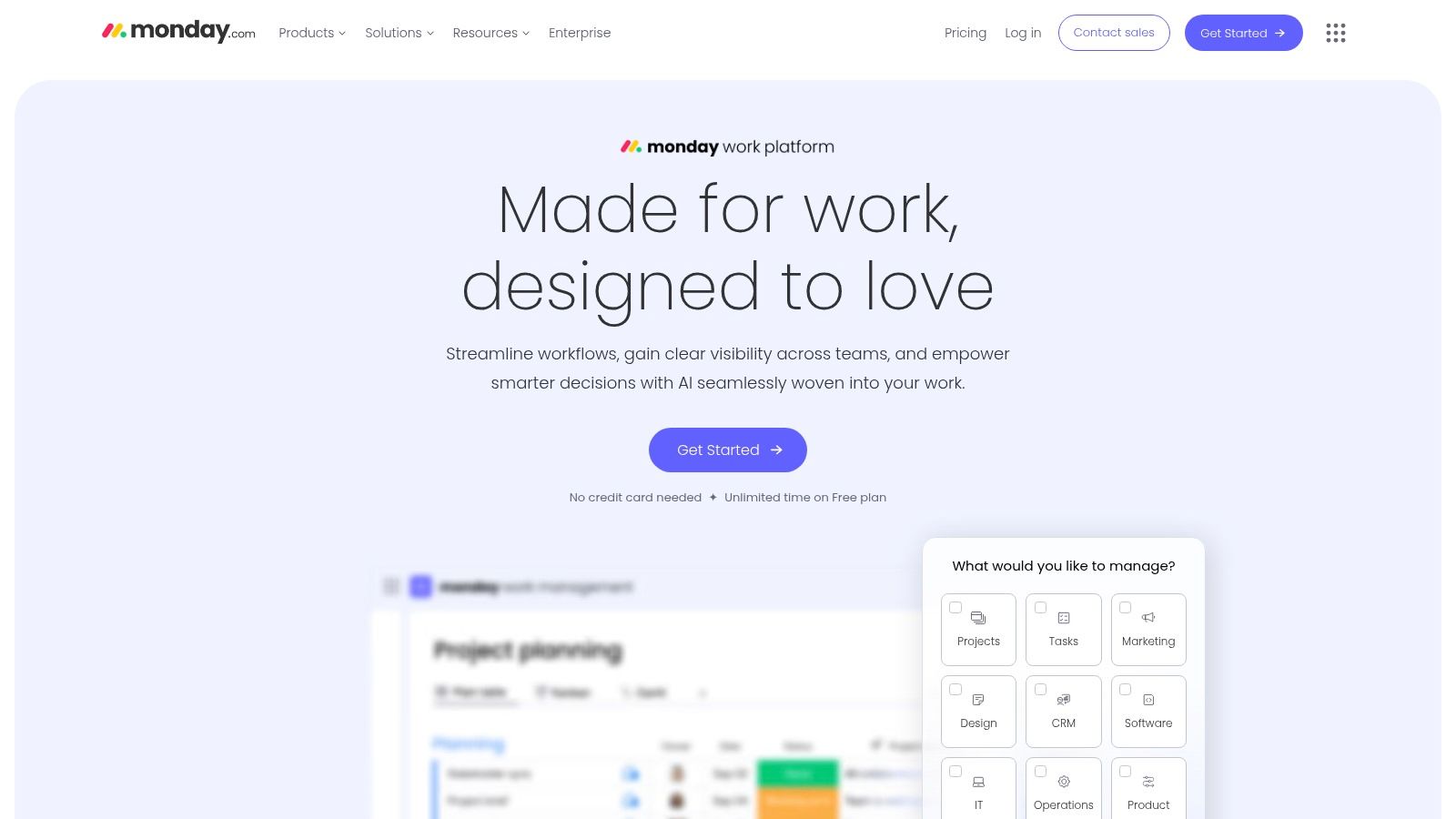
Why It’s a Top-Tier Automation Tool
monday.com’s strength lies in its visual-first approach combined with powerful backend logic. It’s one of the best workflow automation examples because it makes the impact of automation immediately visible on its dynamic boards. Seeing a task card automatically glide from “In Progress” to “For Review” with a new owner assigned provides instant feedback and reinforces the value of the system.
Strategic Insight: The true power of monday.com is using automations to maintain data integrity across different boards. You can set up a recipe so that when a high-level goal is marked as “At Risk” on the executive dashboard, it automatically creates a mitigation task on the relevant team’s operational board, linking the two items for full traceability.
Key Features and Practical Tips
- Automation Recipes: monday.com offers a library of pre-built recipes for common actions like notifications, status changes, and item creation. Pro Tip: Combine multiple recipes on a single board to create a chain reaction. For instance, a status change could trigger a notification, a due date shift, and the creation of a follow-up task in a different group.
- Customizable Dashboards: Aggregate data from multiple boards into a single view. Use this to build a command center that monitors the health of all your automated processes at a glance.
- Deep Integrations: Connects seamlessly with tools like Slack, Jira, and Google Calendar. This allows you to build cross-platform workflows, such as updating a Confluence page when a project milestone is hit in monday.com; you can read more about connecting monday.com and Confluence to see how powerful this can be.
| Feature | What It Is | Pro Tip for Automation |
|---|---|---|
| Status Columns | Customizable labels that track the stage of an item. | Base your most critical automations on these. Automate handoffs by changing the owner whenever the status moves to “QA Testing” or “Client Approval.” |
| Subitems | A way to break down a larger task into smaller, manageable pieces. | Use automation to manage dependencies. Set a rule so that the parent item’s status automatically changes to “In Progress” once the first subitem is started. |
| Time Tracking | A column to log hours spent on a task. | Automate alerts. Create a recipe to notify a manager if the time tracked on a task exceeds its original estimate by more than 20%. |
monday.com offers a free plan for individuals, with paid plans (Basic, Standard, Pro, and Enterprise) unlocking more automation actions and advanced features. While the initial setup requires thoughtful customization to match your exact processes, its highly visual and flexible nature makes it an incredibly powerful and adopted tool for teams looking to streamline their work.
Find it here: https://monday.com/
Workflow Automation Tools Comparison
| Solution | Implementation Complexity | Resource Requirements | Expected Outcomes | Ideal Use Cases | Key Advantages |
|---|---|---|---|---|---|
| resolution Reichert Network Solutions GmbH (monday.com for Jira) | Moderate – requires setup for sync and permissions | Requires both monday.com & Jira licenses | Real-time cross-platform synchronization, enhanced visibility, reduced costs | Cross-functional teams using both monday.com & Jira | Two-way sync, embedded boards, read-only stakeholder access |
| ClickUp | Moderate | Cloud-based, subscription plans | Streamlined project/workflow management, collaboration | Teams needing customizable workflows and integrations | User-friendly, extensive customization, strong integrations |
| Zapier | Low to moderate | Subscription-based, pay per task | Automated multi-app workflows, reduced manual tasks | Users automating repetitive tasks across apps | Huge app ecosystem, no coding, flexible pricing |
| Kissflow | Low | Subscription plans, higher pricing | Quick workflow automation, real-time analytics | Non-technical users automating internal processes | Drag-and-drop, quick deployment, user-friendly |
| Nintex | High | Enterprise-grade pricing | Automate complex processes, enable compliance workflows | Large enterprises with complex document/approval needs | Advanced document automation, strong enterprise integrations |
| Workato | High | Enterprise pricing, robust infrastructure | AI-powered complex automation, real-time sync | Large organizations needing secure, complex integrations | AI-powered, extensive integrations, strong security |
| monday.com | Moderate | Subscription-based | Visual project management, workflow automation | Teams seeking customizable dashboards and collaboration | Intuitive UI, flexible customization, strong collaboration |
Final Thoughts
And there you have it, a whirlwind tour through the wild world of workflow automation. We’ve dissected real-world workflow automation examples from the sleek interfaces of monday.com to the powerful integrations of Zapier and Workato. You’ve seen how tools like ClickUp and Kissflow can turn chaotic processes into finely tuned operational symphonies. The key takeaway? Automation isn’t just a futuristic buzzword; it’s the secret sauce that top-performing teams are using right now to reclaim their time, eliminate soul-crushing manual work, and focus on what truly matters.
You’ve seen that effective automation is less about flipping a magic switch and more about strategic thinking. It’s about dissecting your current processes, identifying the bottlenecks that make your team want to pull their hair out, and then strategically applying the right tool for the job.
Strategic Insight: The most successful automation initiatives don’t try to boil the ocean. They start small, targeting a single, high-impact, and utterly annoying manual task. Master that, prove the value, and then expand your empire of efficiency.
Your Roadmap to Automation Glory
Feeling fired up and ready to banish busywork forever? Excellent. But before you dive headfirst into a sea of triggers and actions, let’s map out your first steps. This isn’t just about buying a subscription; it’s about building a smarter way to work.
Here’s your actionable plan to get started:
- Identify the Pain: Grab your team and a whiteboard (virtual or otherwise). Ask one simple question: “What’s the most repetitive, mind-numbing task we do every single week?” List everything, from data entry to sending reminder emails.
- Prioritize for Impact: Look at your list and rank each item. Which automation would save the most time? Which one would reduce the most errors? Pick one, just one, to be your champion project.
- Choose Your Weapon: Now, revisit the tools we discussed. Is your project a simple, two-app connection? Zapier is your friend. Need to build a complex, multi-layered process with custom approvals? Kissflow or Nintex might be your champion. Is your entire operation centered in one ecosystem? A platform like monday.com or ClickUp offers native automations that feel seamless.
- Build, Test, and Celebrate: Set up your first workflow. Test it thoroughly to iron out any kinks. Once it’s running smoothly, make a big deal out of it! Announce to the team how many hours you’ve collectively saved. Success breeds enthusiasm for more.
Embarking on your automation journey is a powerful step toward creating a more productive, strategic, and frankly, more enjoyable workplace. The examples we’ve explored are just the beginning. The real magic happens when you apply these concepts to your unique challenges, transforming your team’s daily grind into a seamless flow of high-impact work. Go forth and automate!
Ready to bridge the gap between your project management and development teams? If your workflows involve both monday.com and Jira, you know the pain of manual data transfer. resolution Reichert Network Solutions GmbH offers powerful integration tools that create a seamless, automated two-way sync, turning two separate platforms into one cohesive powerhouse. Stop the copy-paste madness and see how resolution Reichert Network Solutions GmbH can supercharge your cross-functional workflows today.
